It’s true what they say about an idea being impossible to kill. I’ve learned this in trying to convince friends that pressing tofu is a Western concept, perhaps even a mistreatment. The idea of boiling tofu in salted water, like they do in China and other East Asian countries, must be fiction, some culinary oddity I’ve made up. They’re so unconvinced they don’t even ask me to explain.
And so I’ll explain the practice and its logic here instead. First I'll talk about the process of pressing tofu before moving onto an explanation of why boiling is both more effective and efficient.
Before we press on (ha ha ha), however, I want to make clear this guide does not refer to silken or super soft tofu. Always assume I am referencing firm-ish bean curd throughout.
My first encounter with boiled tofu as a preparation method
The first time I encountered the idea of boiling tofu was somewhere between 2011-2012, as an observer in a restaurant kitchen in Thailand. As my esurient eyes scanned the kitchen, hungry to understand the various bottles and jars, they landed on the simplest of things: a pot filled with cubed tofu and water.
Language constraints prevented further inquiry so I took to my own research, but I struggled to find much at all. Not one Western cookbook in my collection or on bookshop shelves discussed tofu preparation beyond pressing (to this day this still stands mostly true). It wasn’t until I came across Andrea Nguyen’s then just published book Asian Tofu (highly recommended) before I found an in-road to some answers.
Additional research, combined with compounded experience over time, answered many of my questions and informs how I prepare and cook tofu today. I hope what I’ve learned will be helpful for you as well.
Why do people press tofu?
The purpose of both boiling and pressing tofu is to reduce moisture. The former process is grounded in both reason and preservation of the tender quality of bean curd, while Western cooking educators are hellbent on the view that tofu is unmanageable without the firmest, chewiest possible texture. Cookbook authors instruct readers to use weighty objects or specialist devices to aid in squeezing water out of bean curd in order to achieve this, to make less firm tofu into more firm tofu.
The reason why you can, for the most part, buy tofu made into so many different levels of firmness and consistency is so you take home the right tofu for the job without need for further processing. Western cookbooks and education materials often prime us to focus on the firmest of textures possible, so little attention is paid to other varieties. On top of this, the types of tofu you can buy at Western supermarkets is more limited. This might be a reason why Western consumers may not realise such a variety of bean curd exists to begin with.
Should you press tofu?
In my day to day cooking I face two scenarios that call for pressing tofu.
In Thailand the type of tofu used for some dishes (e.g. pad thai) is a solid, super compressed block of bean curd with no excess water. This isn’t easily found in UK supermarkets (nor in US shops, so far as I’ve seen). When I want to cook recipes that call for such dense bean curd then I press tofu, only because I am unable to purchase it. Most recipes, however, don't require this level of firmness.
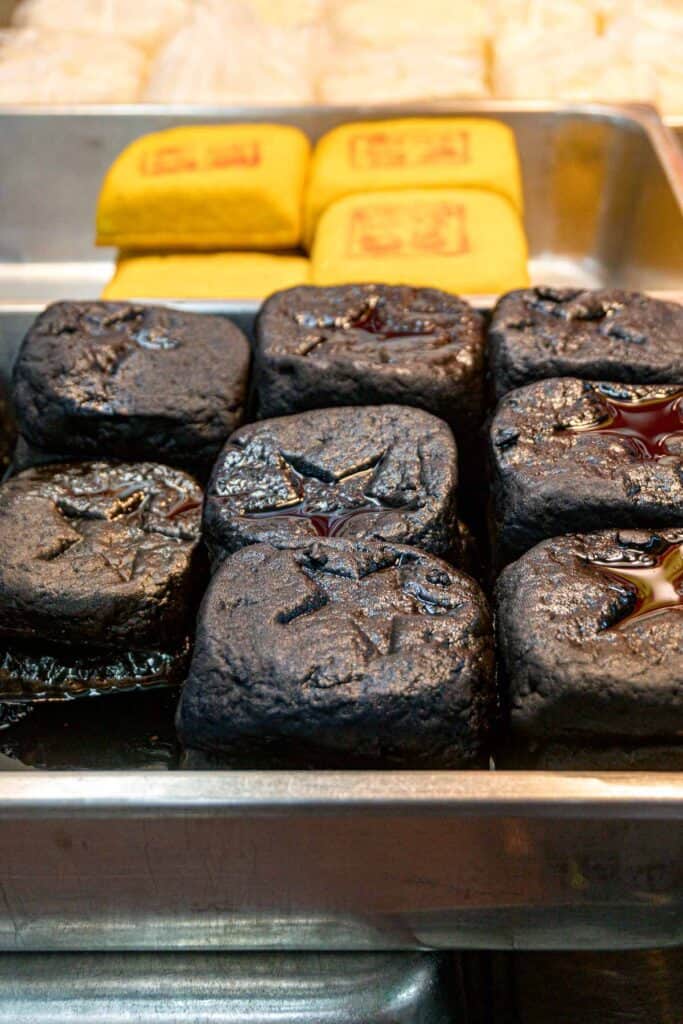
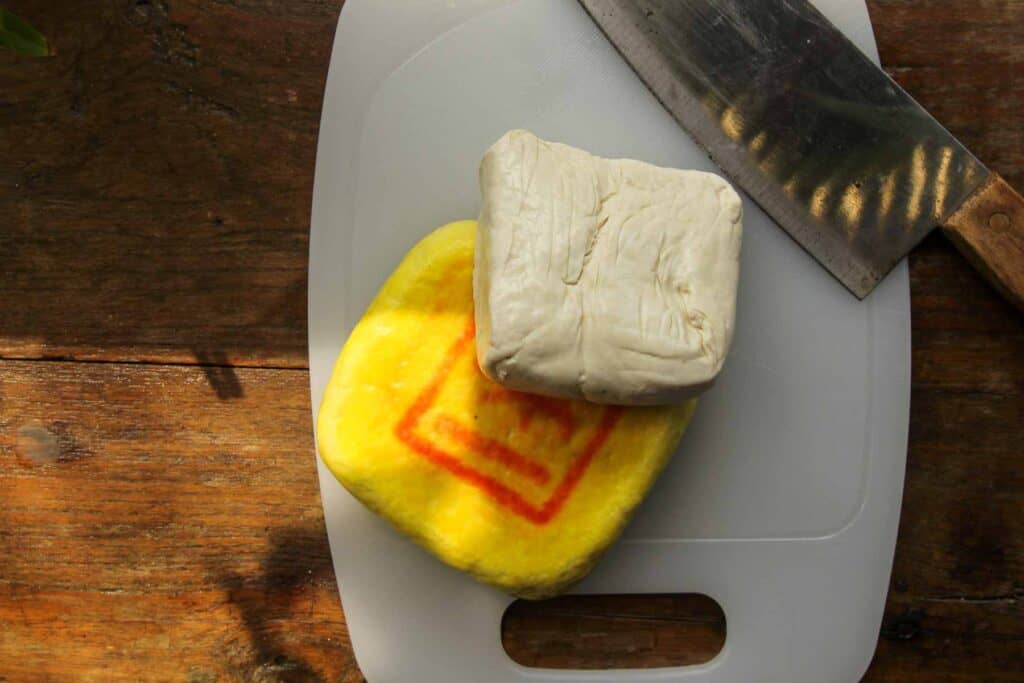
My subsequent reason for pressing tofu is if I’m making something that requires ground up or blended tofu as an ingredient (e.g. mock meats), and I want to minimise liquid.
To summarise, I don’t look at boiling as an alternative to pressing so much as I see them as two wholly different treatments. 99% of the time boiling is the better (and quicker) option. Pressing tofu is rarely necessary. Read on for further explanation of why my claim is true.
Boiling tofu for texture and firmness
In Asian Tofu, Nguyen notes it’s common practice in Chinese cooking to blanch tofu prior to use in preparations that require simmering. This step gives structural integrity to the tofu to see it through intensive boiling processes without breaking apart during cooking (e.g. stews). This same logic applies for any cooking method that would see your tofu knocked about a bit.
The act of adding tofu to salted hot water for a time and then removing it to drain and dry firms up the texture. The process counterintuitively draws moisture from the outer layers because heat brings some of the innermost liquid to the surface of the curd, which you can either blot off with kitchen roll (or a tea towel) or leave to steam dry. Furthermore, the use of salt adds seasoning that improves the flavour.
After draining the salt water treated tofu, the surface firms up. Of particular importance if you intend to fry the tofu is ensuring the surface is dry, which occurs naturally if you leave the hot strained tofu on a tea towel to dry out.
This method is the secret to restaurant quality crispy fried tofu
Wetness in any form is not conducive to crispiness because crispiness is a byproduct of dehydration. So now you have this lovely salt treated tofu with a dry surface. That lack of moisture is going to help you achieve a nice browned crust because you’re not battling a bunch of water. Additionally, the dry exterior means you won’t be dealing with hot oil splashing around your kitchen (and hands and face).
Is this beginning to make sense? I’ll (try to) explain with a further example of frying tempura for added clarity.
It’s all to do with water content
Have you ever made (or ordered) tempura that went limp too quickly after it was cooked? This has to do with water, which most foods contain in high quantities. What happens to water when you heat it? It boils and steam is produced.
As we’ve already established, moisture is the enemy of crispiness.
When you batter and fry your ingredient, you’ll see little bubbles fizzing around the food when it’s in the hot oil. This is the water escaping (both from the ingredient you’ve battered and from the batter itself). When food is heated, the water inside heats up, gets steamy, and pushes its way to the surface. This outward motion not only allows the release of water, but also prevents oil from seeping into the food (to a certain point, but that’s for another discussion). When done well, you end up with a piece of food cooked in the middle and crispy on the outside.
Apply this example to tofu and two things become more clear.
First, the mechanism by which water inside of food can travel to the surface when it’s heated is illustrated more plainly. When food is fried in oil, you can physically see the water escaping as it rises to the surface of the food. The same process of drawing inner moisture to the surface happens when you boil tofu (it’s just not visible to the naked eye).
Second, the reason why removing as much moisture as possible is key to ensuring a more crispy outer layer also becomes more apparent. Because excess moisture is removed from the outer layers of the tofu in boiling, the frying process is more effective. In other words, the crispy texture bestowed from frying is due to dehydration of the surface layers of the tofu, which you’ve aided by the boiling process beforehand.
Marinating tofu is a con. Heat is the answer.
Another myth I wish cookbook authors and bloggers would put to rest is that of the efficacy of marinating tofu. If you don’t believe me, try it for yourself. The next time you plop a slab of tofu into your overnight marinade, slice it the next day and see for yourself how little that liquid has penetrated the bean curd.
Tofu is a pretty dense substance, and marinating works with foods that are more porous in structure. The surface of many of the high protein foods we’re told to marinate are barely permeated when we do this. Again, this is a Western approach to treating tofu that I’ve yet to see elsewhere.
You might argue this is untrue based on the well executed end result of a recipe you’ve followed. Let’s say you’ve followed all the instructions for a marinated and then baked tofu recipe. The flavours of the marinade have penetrated the protein evenly and adequately, so you might argue the act of resting the tofu overnight in seasoned liquid did its job.
Ah, but it didn’t. The reason the tofu is replete with seasoning to its centre is because you cooked it in the marinade. Just like tofu boiled in salted water tastes lightly brined, cooking tofu in soup, sauce, or marinade is what drives the curd to take on flavour. As Hannah Che succinctly states in her brilliant book The Vegan Chinese Kitchen, "Tofu absorbs flavo[u]r when it’s hot, not when it’s cold."
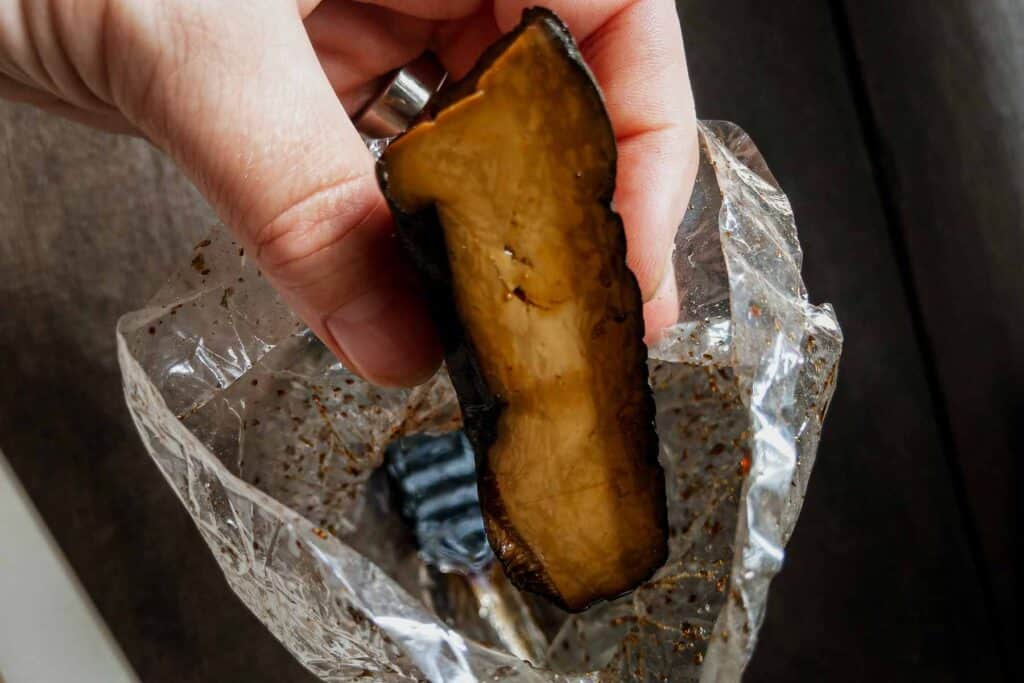
For reference, check out the tofu photo I above. This is the black tofu from the photo I posted toward the beginning of this post, sliced in half. The method of preparing this type of tofu (black tofu, or tao hoo dam เต้าหู้ดำ) is to simmer it slowly for a long time (days, in this case). See how the cooking liquid has permeated the entire block? You would never achieve this with a cold marinade.
There are some exceptions to the rule that marinating is a con, but these only apply to tofu that has been processed beyond a fresh block. Tofu that has been frozen and defrosted undergoes a structural change to the extent that the block will take on liquid in a way that untreat tofu will not. Similarly, other treated tofu products (e.g. bean curd puffs) will absorb liquid more readily.
Methods of treating tofu with boiling water
I use a 2% salt solution, so for 1 litre (1,000 millilitres) of water I add 20 grams of salt (1000 x .02 = 20).
There are two methods for treatment.
- Bring the salted water to the boil in a saucepan. Add the tofu and simmer.
- Add the tofu and salt to a bowl. Boil the kettle and pour the water over the tofu.
I also like to add some MSG for additional seasoning.
How long to boil tofu in salt water
If you're boiling the tofu on the hob, 5-10 minutes will suffice. The longer you simmer, the more seasoned your tofu will be.
If you're pouring boiling water over tofu, without an additional heat source, leave it for 15-20 minutes.
Do I have to use salted water for boiling tofu?
If you're planning to use your tofu in a braised dish or stew with a longer cooking time, use unsalted boiling water. The tofu will pick up the seasonings of the liquid as you continue to cook it, rendering the salt unnecessary.
📖 Recipe
Boiled tofu for seasoning and texture (as an alternative to pressing)
Ingredients
- 750 millilitres water
- 1 tablespoon salt
- ½ teaspoon MSG optional, but recommended
- firm tofu, cut into cubes or slabs depending on what you're cooking
Instructions
- Add the water, salt, and MSG to a medium saucepan and bring to a rolling boil. Tip the tofu in, knock the heat down to a low simmer, and cook for 10-15 minutes.
- Alternatively, add the salt, MSG and tofu to a heatproof bowl and pour the boiling water on top. Leave for 15-20 minutes.
- Strain the water away from the tofu and lay the tofu pieces on a tea towel or kitchen roll (with space in between each piece). You can either blot the moisture off the surface of the pieces or leave them for 20-30 minutes to steam dry. Don't leave the tofu pieces to dry in a colander or they will begin to stick together.

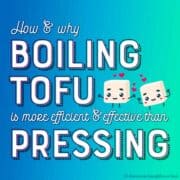

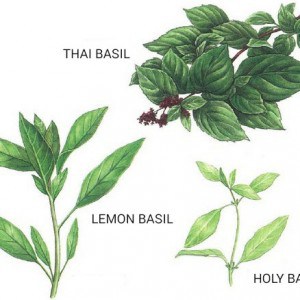


Stacey says
Boiling tofu is a great tip! However there is an exception to your proclamation that marinating is a con. Most folks in North America purchase tofu in plastic containers where the tofu sits in water.* A lot of us freeze the tofu in the unopened container which changes the porosity of the tofu as the water freezes and expands, making the tofu more sponge like. Once drained and/or pressed, it readily soaks up marinade.
*Except silken tofu sold in tetrapaks, where freezing isn't a method used with it.
Kip says
This is a good point. Marinating frozen tofu changes the structure and hence allows for more liquid to be taken in. In this post I am talking specifically about untreated blocks, but I will edit the post to specify this.
Frank says
I've never even heard of boiling tofu before, but I'll be trying it out. I especially like the idea of using it "hot and dry"-- that's really great!
But as for freezing, what I usually do instead of pressing is something I discovered by accident which I call the "freeze-and-squeeze". I cube some drained tofu and then put it into a "Stasher" (silicon zip-top) bag, then I gently roll/squeeze out as much water as I can (without squishing the cubes), sealing the bag while it's still rolled, then flattening it out (so it fits in the freezer). Once it's frozen, I let it defrost in the fridge (takes a few hours), whereupon it's swimming in water again, so then I can roll/squeeze this out and freeze it again, as above. At this point, I'll keep it in the freezer, though if you want, you can repeat the defrost and squeeze again (try it at least once-- it increase the sponginess, and gives it a great "chew"). Without all the water, it takes very little time to defrost, but as it does, it 're-inflates', and if you toss it in cold into a pan sauce while cooking it, it will _soak it up_ and make for a really great flavor!
Incidentally, the slow cooking (or "long hot marinade") sounds like it would be an excellent experiment to try in sous-vide! I'm imagining putting tofu in with some sliced dried shitake mushrooms and a 'dry rub' of spices with salt, since the salt would initially draw out the water from the tofu (rehydrating the mushrooms) and then draw all the flavors back in as it reached osmotic balance. Another idea along the same vein would be to use a good strong miso paste. My mouth's watering thinking of what that would taste like-- woof!
Kip says
Agreed that freezing tofu is an excellent way to get the curd to soak up flavours from external liquids (that's why it's such a popular ingredient for hotpot). I love how versatile tofu is. As for sous vide, I'd love to hear your results if you give that a try!
Rachel says
Thank you. This is very helpful. Any suggestions for storing after? Like how long can I store it in fridge after prepping like this? Can it then be frozen and retain its boiled integrity? Also, would love some recipes on how to use after prepping with boiling. I did finally enjoy some simple fried cubes without using any flour or corn starch that came out just lovely, crispy outside, tender inside. Yum noms.
Kip says
You can either store it in the water it was boiled in or in fresh water. It will keep for a week or two, possibly longer, if you refresh the water it's stored in regularly. If frozen, the structure will change and it will be more spongey (great for soups).
Mary Koomjian says
Thank you for the post and instructions! I googled "can you boil Tofu" and got all the info I needed here. I'm new to cooking Tofu and this will help a lot.
Philip says
With this method, is the tofu always in a block or could you dice the tofu first then let it sit in salted water? Thanks
Kip says
either is fine!
Theodora says
Wow that was a very interesting post!
My question is, would it be ok to just season it and eat it after boiling? Or is it the prep before cooking it in some say (frying, baking etc)? I'm asking mainly digestion-wise, not so much taste-wise.
Thank you!
Kip says
Apologies for how long it's taken me to respond. I am not sure about digestion because I don't have any medical qualifications, but tofu is already a cooked product so you can eat it either as is or after prep.
Greendadof4 says
Apologies for the silly question, but this is after pressing homemade tofu from bean curd?
Kip says
I don't tend to boil tofu when I make it myself for two reasons: 1) I've already pressed the tofu to the consistency I want and 2) I'm likely to be eating it served simple and fresh rather than stewed, to enjoy the fresh soy flavour. I would only boil it were I intending to use it in a long braised or stewed dish.
Chris says
Just like the OP a search for boiling tofu to replace pork & chicken in a Mexican mole was what brought me here. I think I’ll put up my feet and have a full read because I swear I could eat Thai and East Asian food for every meal and never be bored. Thanks for the informative post and the suggestion for Andrea Nguyen’s book.
Kip says
You're most welcome. Thanks for reading!
Reyna says
So if I want to marinate my tofu, but don't plan on stewing it in any dish, what would you recommend? Boiling, then marinating? Boiling, then cooking in marinade? Or just cooking in the marinade from the start?
Kip says
Depennding on the marinade and whether its characteristics would change upon cooking (e.g. if it contains raw garlic that's meant to remain uncooked) I would either boil it and then add it to the marinade or cook it directly in the marinade.
Paige says
Thanks for the very informative post! I found you as the top result in a google search for "how to make flavour permeate tofu", which I have to imagine is a fairly common thing to search for, so hopefully this is going to reach a whole lot of people.
Kip says
I think it is quite common. Maybe this is why my host has started billing me extra lol
Richard Harwood says
Thank you for this great tip.
Karen McCabe says
Hi, I have a pack of firm tofu in the freezer. I was going to marinate it for the bbq. Would it be better if I used your salted water and boil method? I have not had much luck with marinating either frozen or unfrozen blocks. If I use your method and then barbecue for crispness would that work? If so I will make a reduction of the marinade and put it on tofu at end of bbq time. Thanks
Kip says
That's a really good question. I've not experimented with boiling frozen tofu, but I would imagine it would work as you're intending. And I can't imagine any results would be disastrous if it didn't, so I would give it a go. One thing to keep in mind is that frozen tofu will be naturally more porous, so I'd press it lightly between a tea towel after boiling, just to remove excess water (so you don't have a salt lick).
Ida says
Hi Kip,
Thanks for a very helpful post and book recommendations. Can silken tofu (either soft or firm) be boiled as well or would it just fall apart? Or does it absorb flavours so well that boiling isn't necesssary? Thanks.
Kip says
Hey Ida,
Silken tofus are very high in water content so in general don't take flavours onboard so readily. This style of tofu is more for preparations where it's handled lightly, like steaming, dressed and served cold, or spooned into soups for light simmering. In other words, its more of a what you see is what you get product rather than one to treat to change the texture.
Megan says
have you tried boiling it in a stock or flavouring the water beyond just salt?
Kip says
Yes. It depends on use; if you plan to use the tofu in a soup then I think it's likely a wasted step. If y want a more strongly seasoned tofu – say to eat in a cold salad – you might boil it in salted seasoned stock, decant the tofu and stock into a container, and store it in the fridge that way.
Bernard Stephen Knight says
A very useful page. Thanks. I'm a relatively new user to tofu and have frozen & pressed as the prevailing wisdom said I should. Someone (yesterday) under one of the Guardian's Food articles suggested boiling so I Googled & got this.
I am trying this as I write, but wonder what you thought about this. The tofo I'm using is the Tofoo brand (UK based) & they say their product does not require freezing/pressing. Would it be a waste to do boiling as well? I know your answer will come after I've done this but my lack of experience means I will not know if I've improved it or not.
Kip says
I find it interesting what you wrote about the prevailing wisdom of freezing and pressing in combination. If it's the case that there's a sort of standardisation happening around how to prepare tofu in some communities, and it's something that requires extra time and work, it could put people off the ingredient. I wonder if (only a guess) Tofoo may have wanted to let consumers know it's an out of the package product rather than one that required extra treatments to be useable. Hence they say it doesn't require freezing and pressing, which is technically true.
But that doesn't mean you can't freeze it. If you want to make tofu that works well in stews and hotpot, frozen and pressed tofu is a great option (this is generally what I see this used for in Asian food writing and in practice). If you want a tofu that fries really well, I'd still go for the boiling in salted water. Also, boiling isn't going to make the tofu go bad. At worst you'll have some pre-seasoned bean curd.
Ultimately, however, the most important thing is that you're happy with what you're eating and with the results you're getting from the methods you use in the kitchen. If some prevailing wisdom says to do X then give X a go, but if you prefer Y then who cares? Stick with Y. At any rate I'm curious to hear your results/thoughts...
I reserve the right to improve malicious and trollish comments.